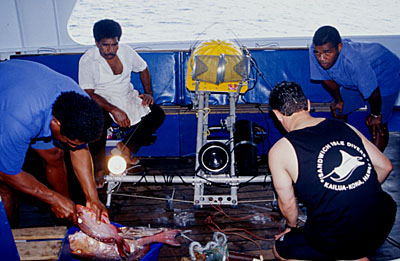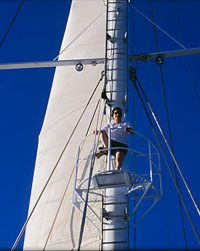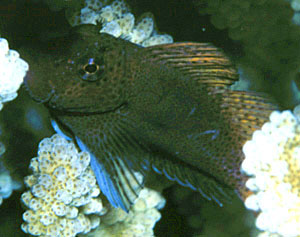|
|
|
(story continued from page 2)
 |
|
Preparing the deepcam
(c) Mary Jane Adams
|
"There is a rapture on the lonely shore,
There is society, where none intrudes,
By the deep sea, and music in its roar"
Byron
That old seafaring cliché about getting your sea legs in three days turned out to be entirely accurate. Voyagers emerged miraculously from their cabins in cheerful anticipation of an arrival to gaze at the horizon on whale watch, ready dive gear and cameras and gather for research briefings. Debate even became heated. It wasn't just that the expedition ichthyologist, New England Aquarium Curator of Fishes and Reptile, Dr Steven Bailey, wanted to collect fish specimens. It was also that he was keen to do it down deep, forcing a long decompression and luring an unpredictable audience of sharks. I volunteered to help but the expedition's physician, a diving and emergency medicine specialist, Dr Craig Cook, reminded us to temper zeal with sagacity.
"We are three days from even the most basic medical facility, five days from Fiji's recompression chamber. Whatever happens, we have to fix it on board. Is this really worth the risk?"
"Like going to the moon and not bringing back moon rocks!" countered Steve.
|
 |
|
Mary Jane Adams on whale watch duty from the crows nest
(c) Mary Jane Adams
|
Mary Jane Adams - Sponsor & Underwater Photographer
I feel privileged to have been a member of the Phoenix Rising Expedition team. It was an unforgettable experience and a major highlight of my 25 years of diving. When I signed up for the project, I hoped that we would discover at least a few good dive sites. But I was delighted to find that every dive was excellent. The Phoenix Islands experience exceeded my most optimistic expectations. Diving with New England Aquarium biologists greatly enriched my understanding of tropical reefs and their inhabitants. If I ever get this kind of opportunity again, I will grab it.
|
|
|
|
So, Craig assisted us in the dive planning and equipment preparation. Rob hovered over videoing us and counting the dozens of sharks patrolling behind our catch bags and NAI'A divemasters stood by with extra Nitrox tanks for shallow-water changeovers. We passed our decompression time examining and collecting in the shallow reef gullies. Hours later we returned with several fish species not previously identified in the region and a couple of species that possibly had never been described at all.
 |
|
Cirripectis jenningsi
(c) Mary Jane Adams
|
In fact, the scientists recorded many such exciting finds. As well as identifying some previously unrecognized sea bird and turtle nesting sites, Austen collected 69 species of algae including one that had only been reported in the South Pacific once before. The team's coral biologist and rapid site assessment expert, Dr David Obura, from East Africa's CORDIO program, completed the group's first-ever coral abundance and diversity surveys and found unparalleled coral health. Photographer, Mary Jane Adams, captured the world's first image of a rare blenny, Cirripectis jenningsi, alive in the wild. The National Geographic Society's deep-sea baited camera rig, on loan to us from Emory Kristof, filmed the region's first six-gill and Pacific sleeper sharks as well as several other fish and invertebrate species living at 3000 feet. Our single deep tow-net collection to 1000 meters revealed strange new creatures. We even found sunken ship wreckage, including what appeared to be harpoons from whaling vessels in the early 1800s. During the 13 diving days in Phoenix, we completed 50 research dives for biological surveys among seven islands, Nikumaroro, McKean, Sydney, Aba-Riringa, Enderbury, Hull and Phoenix. It was often the most demanding diving we had ever done - and by far the most exhilarating!
|
|
|
|
Cat Holloway - Predator & Pelagic Surveys
What an interesting and dynamic group of people! The camaraderie ranges from warm joviality to totally out-of-control excitement. We began as just diving buddies but we'll go home great friends, future colleagues and, in one case, partners and lovers! Bruce just ran into the salon singing about his latest octopus and flashlight fish encounters. "This enchanted evening! We heard dolphins throughout the night dive!"
Our calendars are marked more by diving discoveries than days, miles rather than minutes. Today at Aba-Riringa proved beyond any doubt how incredibly lucky we are to be here doing this.
By 8am we had rolled into the mouth of a channel and were immediately engulfed near the surface by hundreds of unusual parrotfish rushing at us in storm of synchronized spawning! We descended through this mass onto thousands more parrotfish literally carpeting the channel floor, swirling and rising in waves of sexual frenzy. They had timed the mass conception immaculately. As the outgoing tidal current strengthened, the eggs and spawn would be mixed and carried out to sea - hopefully away from predators.
Surrounding this scene were hundreds of hungry tangs and easily a thousand bigeye jacks. Enormous Napoleon wrasses cruised overhead followed by two feasting manta rays! An eagle ray negotiated the traffic and a giant marble ray sat on the edge of the drop-off. A green turtle hovered in the blue while surgeonfish cleaned the algae from its shell. We turned the outside corner to find a spiraling school of chevron barracuda, more hundreds of trevally and 50-odd huge bumphead parrotfish thundering along the reef. All this before breakfast? Phew.
The afternoon was equally exhilarating. Alex and I had an astonishing dive with two more manta rays. One of the pair checked us out carefully then "flew" away. But the second circled us ever closer looking us square in the eye. Clearly intrigued, she played with us for nearly 20 minutes. Bottlenose dolphins escorted us back to the anchorage while tens of thousands of terns migrated back to shore under a brilliant sunset. We settled in to watch the day's much anticipated deep-sea camera footage - knowing that the bait stick was untimely ripped from the rig in another attack from some unfathomable beast. After some weird shrimp, conger eels and a bizarre unidentified shark, a huge six-gill shark swam perfectly into frame! The room erupted with cheering - most loudly from the NAI'A crew who worked for hours to set and retrieve the camera in deep water each day.
The sharks are the best. So handsome, so curious and so many of them! Every dive has at least 10, usually more like 20. On one dive at Nikumaroro we rolled into a school of about 40 juvenile gray reefs! Add to this the ubiquitous blacktip sharks and the sleepy shy whitetips. This truly does feel like the long lost primal ocean paradise that we dreamed it might be.
|
|
|
|
|